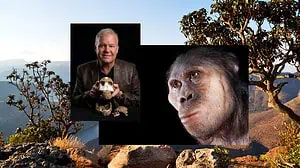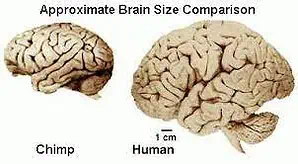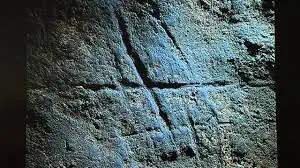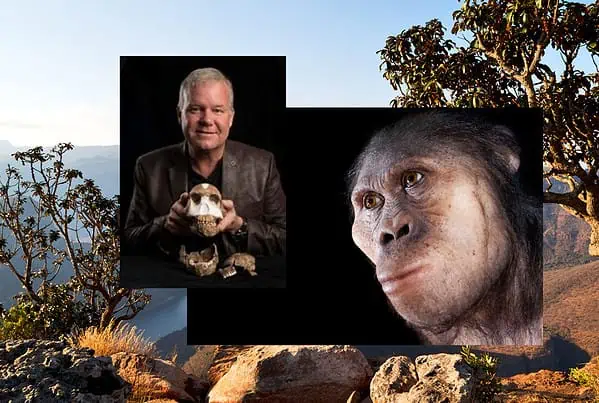“Meaning making, the process of how individuals make sense of knowledge, experience, relationships, and the self, must be considered in designing college curricular environments supportive of learning and development.” — Michael Ignelzi, “Meaning Making in learning and teaching process” 2000
 The philosophical concept of mean making has arisen in the discussion surrounding Homo naledi. Mean making was first introduced by Austrian philosopher and Holocaust survivor Viktor Frankl (photo).
The philosophical concept of mean making has arisen in the discussion surrounding Homo naledi. Mean making was first introduced by Austrian philosopher and Holocaust survivor Viktor Frankl (photo).
According to Psychology Today:
The meaning you give to a loss or trauma can have a profound effect on your life.
Lee Berger made his big announcement for Homo naledi on June 5 at Stoney Brook University in Long Island, New York. Dr. Berger, a professor of evolutionary biology at the University of Witwatersrand in South Africa, presented evidence of active burial of the Homo naledi dead at the Dinaledi cave subsystem.
Additional hominin bones and near complete skeletons of Homo naledi children were announced by Berger. And another surprising find, etched engravings on the cave walls.
From ABC News, June 5, 2023,
Homo naledi had a brain one-third the size of humans but displayed intelligence far beyond, according to new discovery
 Homo naledi, a hominin discovered in the Rising Star cave system in Africa’s Cradle of Humankind in 2013, had human-like hands and feet but a brain a third of the size of humans — a characteristic researchers previously attributed to a marker of far less intelligence than its Homo sapien relatives.
Homo naledi, a hominin discovered in the Rising Star cave system in Africa’s Cradle of Humankind in 2013, had human-like hands and feet but a brain a third of the size of humans — a characteristic researchers previously attributed to a marker of far less intelligence than its Homo sapien relatives.
In recent years there has been an effort to move away from cognitive intelligence based on verbal, numerical and spatial abilities, towards more of an “emotional intelligence” quotient. The move has coincided with a push for multiculturalism within Western ethnically European societies. (Ref. SelfCareFundamentals.com)
Agustin Fuentes, Princeton University evolutionary biologist and a member of the Berger team, is the lead author of a paper just released at BioRxyv, June 5,
Burials and engravings in a small-brained hominin, Homo naledi, from the late Pleistocene: contexts and evolutionary implications
 Burials and related meaning making in a small-brained hominin alter our understandings of human evolution.
Burials and related meaning making in a small-brained hominin alter our understandings of human evolution.
Dr. Fuentes, along with his co-authors including Berger, John Hawks and Keneiloe Molopyane draw attention to “meaning-making.”
earliest evidence of multiple interments and funerary actions, as well as evidence of the early creation of meaning making by a hominin.
“hominin socio-cognitive niche and its relation to meaning-making activities is more diverse than previously thought” — Dr. Fuentes
Additionally, they make a bold claim that brain size may not matter as much as previously believed. They assert that meaning making is evidence in and of itself of high intelligence creatures.
The hominin undertaking these behaviors was the small-brained Homo naledi. These data call into question several key assumptions about behavioral and cognitive evolution in Pleistocene hominins. The evidence from Dinaledi push back the temporal origins of mortuary and funerary behaviors and associate the creation of meaning making with a small-brained species and thus challenge key assumptions about the role and importance of encephalization in human evolution.
The association of these activities in subterranean spaces accessed and modified by the small brained species Homo naledi impacts assertations that technological and cognitive advances in human evolution are associated solely with the evolution of larger brains.
Bigger brains may not equate to higher intelligence after all — Julia Jacobo, ABC News
Continuing from ABC News:
 Bigger brains may not equate to higher intelligence after all, according to a remarkable discovery about an early hominin.
Bigger brains may not equate to higher intelligence after all, according to a remarkable discovery about an early hominin.
Homo naledi, a hominin discovered in the Rising Star cave system in Africa’s Cradle of Humankind in 2013, had human-like hands and feet but a brain a third of the size of humans — a characteristic researchers previously attributed to a marker of far less intelligence than its Homo sapien relatives.
As chronicled here at Subspecieist.com, both Berger and Hawks have hinted rather strongly in past lectures, much of them available on YouTube, that DNA extraction is a possibility for Homo naledi. Re-dating for Homo naledi has put the species at 210,000 to 325,000 years ago. That would make it contemporary with modern Homo sapiens. Jebel Irhoud from Morocco is considered the first Homo sapien, along with Omo 1 from Kenya and Herto Man from Ethiopia at approximately 200,000 years ago.
Berger in his presser promised more spectacular news to come.
Lowering the bar on importance of brain size to human intelligence
From MSN, the Star, June 11,
S Africa finds evidence of clever man ancestor
 Agustín Fuentes, National Geographic explorer and on-site biocultural specialist, said, “What we can say is that these are intentionally made geometric designs that had meaning for naledi. That means they spent a lot of time and effort and risked their lives to engrave these things in these places where they’re burying bodies.”
Agustín Fuentes, National Geographic explorer and on-site biocultural specialist, said, “What we can say is that these are intentionally made geometric designs that had meaning for naledi. That means they spent a lot of time and effort and risked their lives to engrave these things in these places where they’re burying bodies.”
Berger said, “I think we are facing a remarkable discovery here of hominids, nonhumans with brains, a third the size of living humans slightly larger than the chimpanzee that we are attributing to burying their dead, something previously only found in large brain hominids prior to this as well as making meaning-making symbols on the wall.”
Homo naledi admixture with modern extant Africans?
A 2003 study published at sciencedirect.com by Canadian college professors Philip and Elizabeth Ruston found a rather significant difference in brain size between Africans, Europeans and East Asians.
Brain size, IQ, and racial-group differences: Evidence from musculoskeletal traits
African-descended people (Blacks) average cranial capacities of 1267 cm3, European-descended people (Whites) 1347 cm, and East Asian-descended people (East Asians) 1364 cm. These brain size differences, containing millions of brain cells and hundreds of millions of synapses, were hypothesized to underlie the race differences on IQ tests, in which Blacks average an IQ of 85, Whites 100, and East Asians 106.
According to Scientific American, “Does brain size matter,”
correlates with intelligence, with a correlation value between 0.3 and 0.4 out of a possible 1.0. In other words, brain size accounts for between 9 and 16 percent of the overall variability in general intelligence…
Note – Chimpanzee brain size is estimated to be ~350cc. Homo naledi is at 450 to 600cc.



The Homo naledi saga is getting weirder and weirder. I can’t help wondering if this is related to the delayed announcements, the Berger as Svengali narrative they’re now trumpeting, and a once-transparent site and working group going inexplicably dark.
Keep in mind, the papers we are discussing today are not peer-reviewed, at least not by scientists or anyone committed to objective commonsense.
The general theme of it all can be summed up with the well-known legal phrase: It assumes facts not in evidence.
From the paper cited here, “Burials and engravings in a small-brained hominin, Homo naledi, from the late Pleistocene: contexts and evolutionary implications” Beginning at Line 23:
“. . . 250-350,000 years ago . . . Homo naledi . . . carried deceased conspecifics into difficult to access locations in the Rising Star Cave system . . .”
There is no way of knowing how the cave system resembles its present configuration hundreds of thousands of years later. It’s been claimed that geologists can’t find anything obvious today, but I’ve also heard Berger himself say at one point that there must have been another entrance. Some “difficult to access locations” they presume could have been substantially different back in the day. And we know the cave system has not exactly been static: We have calcifications, floes, breccia, and the cave floors have been subject to slow but measurable hydrologic movement and drainage.
But what’s the evidence that the Homo naledi specimens were “carried?” NONE.
IF they were carried, what’s the evidence that it was Homo naledi that carried the bodies? NONE. There were at least two other hominins more advanced than Homo naledi in Africa at the time.
This also means that another associated point by the Berger Bunch is also in question: Evidence of fire in the caves cannot unquestionably be attributed to naledi, others were proven capable of that.
“. . . and interred them . . .”
None of the players running the site have expertise in interments (burials). To be fair, why would they? This is not behavior thought to have been of much relevance in their fields.
Burials are the bailiwick of archaeologists specializing in relatively recent human activities. Archaeologists are trying to be polite about it, but pushback is already starting to come that Berger and company are engaging in fatally-flawed work along these lines. Upshot: the professional suspicion is that, based on the facts published so far, what we are looking at here aren’t burials at all.
“. . . and likely produced engravings on cave walls near those areas of interment.”
The scratchings on a pillar look intelligently manufactured to my eye. But we don’t find any tools that could have made them. In fact, we don’t have any tools at all in the entire cave system. What we do have is abundant evidence of post-naledi cave intrusion by modern cavers and possibly others in the past. There is evidence that some naledi skeletons have been moved and intelligently re-arranged. There is no evidence — NONE — that the “engravings” were made by Homo naledi or during Homo naledi’s era at all.
With none of the key facts established, Agustin Fuentes frolicking with the unicorns about “socio-cognitive niches” and “meaning-making activities” have no foundation for discussion. Go back to your crystals.
The other point Berger et al touch upon may have more relevance — brain size. Unsubstantiated claims aside, the existence of naledi in itself might be part of a pattern.
Neanderthals had bigger brains than sapiens. Homo floresiensis had a brain much smaller than what was expected from its accomplishments. Now if smaller-brained naledi in some respects turns out to complete this trifecta . . .
Well, it’s beginning to look to some degree that hominin brain architecture, not just size, can be critical in determining advanced cognition and behavior.
There is solid scientific research going on today supporting this. But the woke crowd ain’t gonna like it.
**TIME WARP NEWS**
Lee Berger XIII concludes NY subway graffiti the product of rodent culture
“The key to understanding their social structure is the coded patterning of the coprolites,” Berger explained. “But the biggest unanswered question is figuring how rats manage to press spray can buttons wit dey tiny feets.”
Berger says that his previous interpretation that the body deposition was the product of natural fluvial activity in the cave was incorrect. He now interprets body sites “dug” 10 inches deep and the accumulation of multiple individuals in the same space as “overlapping graves.”
In this press conference by Berger, illustrations of alleged naledi burials are misrepresentative. The skeletal remains are more articulated, more human in appearance, and the “graves” are more than twice as deep than true scale.
He calls a sole admittedly ambiguous curved rock in proximity with some finger bones, teeth and rib bones as a “13 year old’s hand holding or nearly holding a curved rock” — hence supporting his claim of naledi tool use.
One thing that comes across in this presentation is that the “engravings” in the photographs are highly filtered, digitally enhanced and much smaller than you think. Berger displays a photograph of what he calls the largest engraving with a ruler — a crosshatching of lines appearing to be some 6 inches by 6 inches. There is no question that the markings he cites are artificial, not produced by nature.
In one of the three non-peer reviewed papers Berger just released, he says that this cross-hatching is one of three “triptych panels” on the opposite side of the one same pillar with two other “engravings.” Berger implies this is some kind of primitive signage of burial sites although he does not quite speculate whether the markings are ceremonial, indicate a cemetery, or advertise “Grok’s Funeral Emporium.”
Instead, Berger submits that the markings in the naledi cave are virtually identical with symbolic carvings made by Homo in Europe more than 200,000 years later. In photographs he directly compares them with Gibraltar Neanderthals. In one of the three papers he submits, he compares it with the renowned “32 symbols” popularized by Genevieve Von Petzinger found in widespread human caves.
Berger says here that “there is no evidence that Homo sapiens moved beyond the light zone” in the naledi cave system. That is untrue and he knows it: the caves were marked deeply in the unlit sections with unaccounted spelunking markers.
https://www.youtube.com/watch?v=fFbgQhY4Yxw&t=2s